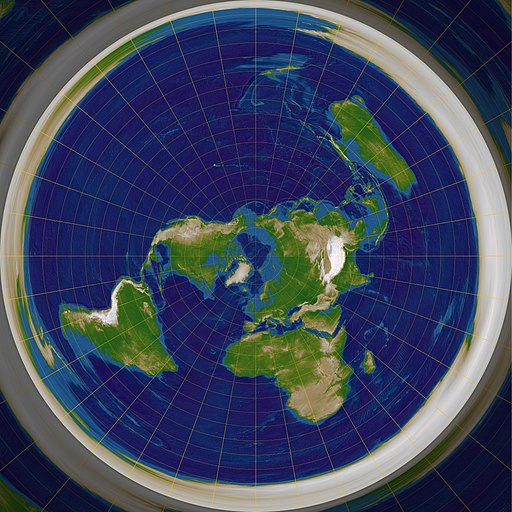Riemannian manifold \((M,g)\)에 affine connection \(\nabla\)가 정의되면 exponential map이라는 특별한 함수를 정의할 수 있다.
Exponential Maps
\(p\) 를 \(M\) 위의 point라고 하고, \(v\) 를 \(p\) 에서의 tangent vector라고 하자. 그러면,
$$ \begin{eqnarray} \gamma_v (0) & = & p \\ \\ \dot{\gamma}_v (0) & = & v \end{eqnarray} $$
를 만족하는 geodesic \(\gamma_v : I \subset \mathbb{R} \to M\) 이 유일하게 존재한다. 이를 이용해, exponential map을 다음과 같이 정의한다.
Riemannian manifold \((M,g)\) 에 대하여 affine connection이 정의되면, \(M\) 위의 점 \(p\) 에 대하여 exponential map \(\exp _p : T_pM \to M\) 을 다음과 같이 정의한다.
$$ \exp _p (v) = \gamma_v (1) $$
( \(\gamma_v\) 는 \(\gamma_v(0)=p\) , \(\dot{\gamma}_v(0)=v\) 를 만족하는 geodesic )
만약, 어떤 tangent vector \(w\) 로 정의되는 geodesic \(\gamma_w\) 의 parameter interval \(I\) 가 1을 포함하지 못하는 경우에는 \(w\) 의 exponential map은 잘 정의되지 못한다.
\(\gamma _v\)를 reparametrization하여,
$$ \eta (t) = \gamma_v (ct) $$
로 정의하면,
$$ \dot{\eta}(t) = c ~\dot{\gamma}_v(ct) $$
이므로
$$ \nabla _{\dot{\eta}(t)} \dot{\eta}(t) = \nabla _{c~\dot{\gamma}_v(ct)} ~(c~\dot{\gamma}_v(ct)) = 0 $$
즉, geodesic이고
$$ \begin{eqnarray} \eta(0) & = & p \\ \\ \dot{\eta}(0) & = & c~\dot{\gamma}_v(0) = cv \end{eqnarray} $$
따라서
$$ \eta (t) = \gamma _{cv} (t) = \gamma_v (ct) $$
임을 알 수 있다.
만약 \(\gamma_v\)의 maximal interval이 \(\left(-a,b\right)\) 로 유한하다면, \(\gamma_{cv}\)의 maximal interval이 \(\left(-\frac{a}{c},\frac{b}{c}\right)\) 로 더 작은 interval이 된다. 따라서 tangent vector의 크기가 너무 크게 되면 maximal interval에 1이 포함되지 않게 되어 exponential map이 더 작은 vector와 겹치게 된다.
그러므로 exponential map은 \(T_pM\) 의 원점을 기준으로 원점을 포함하는 open set(즉, zero tangent vector의 neighborhood)에서만 정의된다.
THEOREM Normal Neighborhood
Exponential map \(\exp _p : U \to V \subset M\) 이 diffeomorphism이 되는 zero tangent vector의 neighborhood \(U \subset T_pM\) 가 존재한다. 이때 exponential의 image \(V=\exp_p (U)\) 를 \(p\) 의 normal neighborhood라고 부른다.
만약 \(M\) 의 모든점에서 각각의 tangent vector 전부에 대하여 exponential map을 정의할 수 있는 경우 affine connection을 complete하다고 부른다.
Example: Exponential Maps on Unit Sphere
반지름 1인 구표면을 3.1-(2) Gradient of Function의 예제에서 살펴본 것과 같은 parametrization으로 표현하자.
$$ \Psi(\theta,\varphi) = (\sin\theta \cos\varphi, \sin\theta \sin\varphi, \cos\theta) $$
이제 구표면 위의 점 \(p=(1,0,0)\) 에 대하여, 정의역 \((-\pi,\pi)\) 에 curve
$$ \eta (t) = (\cos{t},\sin{t},0) $$
를 정의하자. 이 curve는 자오선, 즉 geodesic이고,
$$ \begin{eqnarray} \eta(0) & = & (1,0,0) \\ \\ \dot{\eta}(0) & = & (0,1,0) = \frac{\partial}{\partial \varphi} \end{eqnarray} $$
이므로 위의 논의에 따라서 \( \eta = \gamma_{\frac{\partial}{\partial \varphi}} \) 임을 알 수 있다. 따라서,
$$ \exp _p \left(\frac{\partial}{\partial \varphi}\right) = (\cos{1},\sin{1},0) $$
이제 tangent vector의 길이를 늘려서 curve를 정의하면,
$$ \gamma_{c\frac{\partial}{\partial \varphi}} (t) = \gamma _{\frac{\partial}{\partial \varphi}} (ct) = (\cos{(ct)},\sin{(ct)},0) $$
이므로 \(|c|<\pi\)에서 exponential map은 겹치지 않는다. 그러나 \(|c|\ge\pi\) 인 경우 exponential map의 image가 겹치게 된다. 예를 들어,
$$ \exp _p \left(2\pi \frac{\partial}{\partial \varphi}\right) = (1,0,0) = \exp _p (0) $$
구표면은 회전에 대하여 대칭이므로, 임의의 tangent vector의 방향에 대하여, 길이가 \(\pi\)보다 작은 경우 exponential map이 잘 정의된다. 종합하면,
$$ U = \left\{~ \left. a \frac{\partial}{\partial \theta} + b \frac{\partial}{\partial \varphi} ~\right|~ a^2 + b^2 = \pi^2 ~ \right\} \subset T_p S^2 $$
로 정의하면, exponential map
$$ \exp_p : U \to S^2 \backslash (-1,0,0) $$
은 diffeomorphism이 된다. 이 때, exponential map의 image
$$ S^2 \backslash (-1,0,0) $$
가 \(p\)의 normal neighborhood가 된다. 아래 그림은, 북극에서 정의되는 exponential map을 tangent space에서 표현한 그림이다. (tangent space의 각 점이 exponential map에 의해 그림에서 표현된 지표면의 위치에 대응된다.) 위에서 본 것과 같이, exponential map이 diffeomorphism이 되는 zero vector의 nieghborhood는 원이 됨을 확인 할 수 있다.
By RokerHRO [GFDL or CC BY-SA 3.0 ], from Wikimedia Commons
Normal Coordinates
Levi-Civita connection이 정의된 Riemannian manifold \((M,g)\) 위의 점 \(p\)에 대하여, \(p\)의 normal neighborhood에 특별한 형태의 coordinates를 정의할 수 있다. 만약, tangent space \(T_pM\) 의 basis를 \( \{ v_1, v_2, \cdots ,v_n \} \) 라고 하면, normal neighborhood에 parameterization
$$ \psi (x^1,x^2, \cdots, x^n) = \exp_p (x^1 v_1 + x^2 v_2 + \cdots + x^n v_n) $$
으로 정의되는 local coordinates \((x^1,x^2,\cdots,x^n)\) 을 Riemannian normal coordinates라고 부른다.
Normal coordinates는 다음과 같은 특징을 가진다.
- \(p\) 의 tangent vector \(v\) 가 normal coordinates에서 $$ v= \sum_{i=1} ^n v^i ~\left(\frac{\partial}{\partial x^i}\right)_p $$로 표현되는 경우, \(\gamma_v\)는 $$ \gamma_v(t) = (tv^1,tv^2,\cdots,tv^n) $$으로 표현된다.
- \(p\) 의 coordinates는 \((0,0,\cdots,0)\) 이다.
- Christoffel symbol \(\gamma ^i _{jk} = 0\) 이다.
- 만약, \( \{v_1,v_2,\cdots,v_n\} \) 이 orthonormal이면, normal neighborhood의 점 \(q\) 에 대한 tangent space \(T_qM\) 의 basis $$ \left\{ \left(\frac{\partial}{\partial x^1}\right)_q,\left(\frac{\partial}{\partial x^2}\right)_q,\cdots,\left(\frac{\partial}{\partial x^n}\right)_q \right\} $$도 orthonormal, 즉 \(g_{ij} = \delta _{ij}\) 가 된다.
'Mathematics > 다양체(텐서)' 카테고리의 다른 글
| [다양체,텐서] 3.5-(1) Lie Groups, Lie Algebras ② (1) | 2018.10.08 |
|---|---|
| [다양체,텐서] 3.5-(1) Lie Groups, Lie Algebras ① (0) | 2018.10.07 |
| [다양체,텐서] 3.4-(1) Example: Geometry on Unit Sphere (0) | 2018.10.05 |
| [다양체,텐서] 3.4 Levi-Civita Connection (0) | 2018.10.05 |
| [다양체,텐서] 3.3 Parallel Transport, Geodesics (0) | 2018.09.26 |
| [다양체,텐서] 3.2-(2) Coordinates Changes of Christoffel Symbols (0) | 2018.09.26 |
